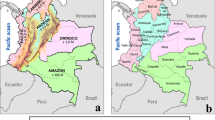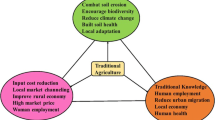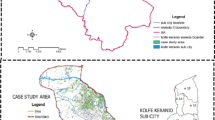Abstract
Onion is one of the high-value crops in the Philippines and Nueva Ecija is the leading onion producer in the country. Though onion is one of the most profitable high-value crops, it is very susceptible to armyworm infestations resulting in huge income loss to the farmers. To avoid losses in the future and expedite assistance by the government in the heavily infested areas, the pattern, spatial information and mapping of armyworm infestation and damage are information of vital importance. However, its importance is still far from realization by the farmers and decision makers, which at present are still depending on the traditional methods of estimating losses in yield/ha basis. Geographic Information System is the most advanced technology used in resources mapping which could also use in identifying heavily infested area through “Hot Spot Analysis”. Hotspot analysis was conducted in this study to identify the spatial pattern and possible sources of armyworm infestation outbreaks. The result shows that the onion area of San Jose was classified as the highest hot spot area of armyworm infestation. On the other hand, the onion areas in the municipalities of Cuyapo, Guimba, San Leonardo, Rizal, General Natividad, Laur, and Bongabon, were also found to be high hot spot areas of infestation, though in moderate scale of damage. The municipalities of Lupao, Munoz, Gabaldon, Santo Domingo, Talavera, Quezon, and Aliaga, were found to be at very low to moderate hotspot status. GIS was proven to be effective in generating hot spot maps of armyworm based on the levels of infestation in the onion areas of Nueva Ecija.





Similar content being viewed by others
References
Burnie, G., Forrester, S., Greig, D., Guest, S., Harmony, M., Hobley, S., et al. (1999). Botanica: The illustrated A–Z of over 10,000 garden plants (3rd ed., p. 74). New South Wales: Random House Australia Pty Ltd.
Philippine Statistics Authority. (2016). Selected statistics on agriculture, p. 10.
Navasero, M., (2016). Invasive pests: The case of the 2016 outbreak of the “onion armyworm” in Nueva Ecija. In SCS annual meeting and 11th scientific symposium. The Acacia Hotel, Alabang, Muntinlupa City, September 28, 2017.
Peshin, R., & Dhawan, A. K. (2009). Integrated pest management: innovation-development process. Dordrecht: Springer.
Yan, Y., Feng, C. C., & Chang, K. (2017). Towards enhancing integrated pest management based on volunteered geographic information. ISPRS International Journal of Geo-Information,6, 224. https://doi.org/10.3390/ijgi6070224.
Litsinger, J., Libetario, E., & Canapi, B. (2009). Eliciting farmer knowledge, attitudes, and practices in the development of integrated pest management programs for rice in Asia. In R. Peshin & A. K. Dhawan (Eds.), Integrated pest management: Dissemination and impact (Vol. 2). Berlin: Springer. https://doi.org/10.1007/978-1-4020-8990-9_5.
Krivoruchko, K., & Gotay, C. A. (2003). Using spatial statistics in GIS. In: International congress on modelling and simulation, edited by D A Post (pp. 713–736).
Tobler, W. R. (1979). Cellular geography. In S. Gale & G. Olsson (Eds.), Philosophy in geography (pp. 379–386). Dordrecht: Reidel.
Goovaerts, P. (1997). Geostatistics for natural resources evaluation (p. 496). New York: Oxford University Press.
Webster, R., & Oliver, M. A. (2001). Geostatistics for environmental scientists. Statistics in practice (p. 265). Chichester: Wiley.
Nielsen, D., & Wendroth, O. (2003). Spatial and temporal statistics—Sampling field soils and their vegetation. GeoEcology textbook (p. 614). Reiskirchen: Catena-Verlag.
Hengl, T. A. (2007). Practical guide to geostatistical mapping of environmental variables. Italy: European Commission, Joint Research Centre, Institute for Environment and Sustainability.
Chakravorty, S. (1995). Identifying crime clusters: The spatial principles. Middle States Geographer,28, 53–58.
Shojaei, S., Alipur, H., Ardakani, A. H. H., Nasab, S. N. H., & Khosravi, H. (2018). Locating Astragalus hypsogeton Bunge appropriate site using AHP and GIS. Spatial Information Research,26(2), 223–231.
Cheshmidari, M. N., Ardakani, A. H. H., Alipor, H., & Shojaei, S. (2017). Applying Delphi method in prioritizing intensity of flooding in Ivar watershed in Iran. Spatial Information Research,25(2), 173–179.
Alberto, R. T. (2014). Pathological response and biochemical changes in Allium cepa L. (bulb onions) infected with anthracnose-twister disease. Plant Pathology & Quarantine,4(1), 23–31. https://doi.org/10.5943/ppq/4/1/4.
Getis, A., & Ord, J. (1996). Local spatial statistics: an overview. In P. Longley & M. Batty (Eds.), Spatial analysis: Modeling in a GIS environment (pp. 269–294). Cambridge: GeoInformation International.
Songchitruksa, P., & Zeng, X. (2010). Getis–Ord spatial statistics to identify hot spots by using incident management data. Transportation Research Record Journal of the Transportation Research Board,2165, 42–51. https://doi.org/10.3141/2165-05.
Jana, M., & Sar, N. (2016). Modeling of hotspot detection using cluster outlier analysis and Getis–Ord Gi* statistic of educational development in upper-primary level, India. Modeling Earth Systems and Environment,2, 60. https://doi.org/10.1007/s40808-016-0122-x.
Trematerra, P., & Sciarretta, A. (2014). Geostatistical tools for the study of insect spatial distribution: Practical implications in the integrated management of orchard and vineyard pests. Plant Protection Science,50, 97–110.
Samsonova, V. P., Blagoveshchenskii, Y. N., & Meshalkina, Y. L. (2017). Use of empirical Bayesian kriging for revealing heterogeneities in the distribution of organic carbon on agricultural lands. Eurasian Soil Science, 50, 305. https://doi.org/10.1134/S1064229317030103.
Krivoruchko, K. (2012). Empirical Bayesian Kriging. ArcUser Fall 2012.
Che Hasan, R., Ierodiaconou, D., & Monk, J. (2012). Evaluation of Four supervised learning methods for benthic habitat mapping using backscatter from multi-beam sonar. Remote Sensing,4, 3427–3443.
Cohen, Y., Sharon, R., Sokolsky, T., & Zahavi, T. (2011). Modified hot-spot analysis for spatio-temporal analysis: a case study of the leaf-roll virus expansion in vineyards. In Spatial Conference: Spatial Data Methods for Environmental and Ecological Processes, Foggia IT, 1–2 September 2011.
Cui, H., Stein, A., & Myers, D. E. (1995). Extension of spatial information, Bayesian kriging and updating of prior variogram parameters. Environmetrics, 6(4), 373–384.
Dai, H. Q., Zhang, G. L., & Zhang, W. J. (2017). Temperature dependent development parameters and population life table of beet armyworm, Spodoptera exigua (Hübner) (Lepidoptera: Noctuidae). Arthropods,6(4), 117–125.
Acknowledgements
This research is an output of the DA-BAR funded research project “Detection, Spatial Tracking, Damage and Yield Assessment and Mapping of Disease and Armyworm Infestations of Onion Using Remote Sensing Technology. We are grateful to the Department of Agriculture---Bureau of Agricultural Research (DA-BAR) for the financial support.
Author information
Authors and Affiliations
Corresponding author
Additional information
Publisher's Note
Springer Nature remains neutral with regard to jurisdictional claims in published maps and institutional affiliations.
Electronic supplementary material
Below is the link to the electronic supplementary material.
Rights and permissions
About this article
Cite this article
Alberto, R.T., Biagtan, A.R., Isip, M.F. et al. Hot spot area analysis of onion armyworm outbreak in Nueva Ecija using geographic information system. Spat. Inf. Res. 27, 673–680 (2019). https://doi.org/10.1007/s41324-019-00266-0
Received:
Revised:
Accepted:
Published:
Issue Date:
DOI: https://doi.org/10.1007/s41324-019-00266-0




